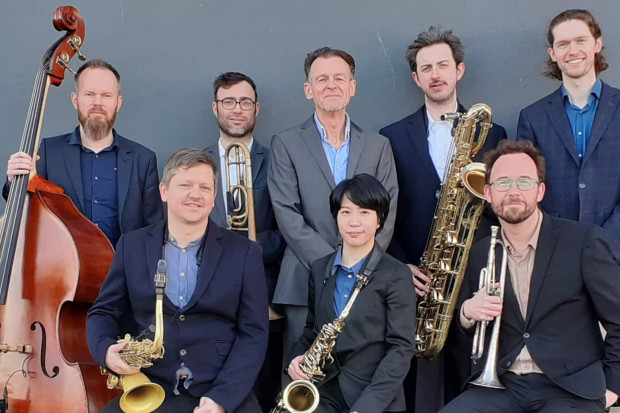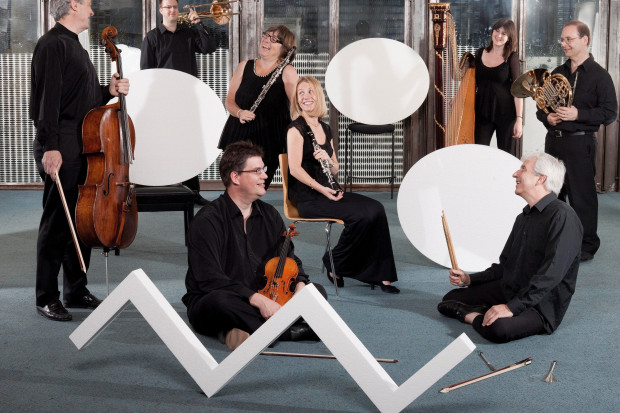
Shiva Feshareki and the BBC Concert Orchestra.
Spinning the Orchestra
As part of the EFG London Jazz Festival, the BBC Concert Orchestra presented a programme called Jazz Reimagined. The pairing of concert and festival seemed a little forced however; a long and packed programme, there were four orchestral jazz arrangements, although at the concert’s heart was the premiere of Shiva Feshareki’s Dialogues for turntable and orchestra, and James Tenney’s 1974 Chorales for Orchestra, both works in which the connection to jazz was difficult to define.
The result was a programme of two unrelated, even jarring, halves, the first of fairly unambitious orchestral jazz arrangements and works, the second of challenging, beautiful and exciting contemporary music. The first half opened with Gordon Hamilton’s Baby Steps First, based on Coltrane’s Giant Steps, followed by a fairly sterile arrangement of Wayne Shorter’s Nefertiti by Guy Barker, and Dave Heath’s The Frontier. There was a kind of chaotic charm though to BBC Concert Orchestra conductor Bramwell Tovey’s own work Pictures in the Smoke in its evocation of Dorothy Parker’s ‘holding court’ at the Algonquin Round Table.
Charged and restrained
The second half began with the stunning Tenney work, chosen by featured composer Shiva Feshareki as a complement to her own work. The Chorales are an experiment in control and colour palette, four movements based on versions of the same melodic line and a harmonic structure based on the harmonic series. The joyful exuberance of the first half made the extreme restraint of this work all the more intense, in a subtle and charged performance from the orchestra.
Palindromic cross-fade
Feshareki describes Dialogues as a ‘play on perspective’; the work is a long, palindromic ‘cross-fade’ between turntables and orchestra, a kind of musical mirror image – if the mirror in question was in a funhouse. The source material was a recording of the orchestra, played backwards and manipulated live by Feshareki, conjuring from the massed sound low throbbing beats and drones, fragments of melodies built from tiny extracts of strings, manufactured beeps, and even orchestral stabs reminiscent of 90s keyboards. It was fascinating in both the soundworlds it produced, and also the erraticism of her weaving together of the material, never settling for long on one sound or combination of sounds for long. It was restless and searching and explorative – perhaps descriptions rarely associated with orchestral performances – though some ideas felt so rich they deserved more time to develop, and gentler treatment.
Dialogues was also a demonstration of the potential of turntables as a performance instrument; Feshareki’s playing was immediate and physical, and totally absorbing. However, at times the sound became so abstracted, so subsumed into the scratches, loops and manipulations, that its relationship to the original sonic material became lost entirely.
When the central ‘duet’ arrived – the orchestra entrance and turntable closing crossing over – the relationship between the two sections felt quite distant. Feshareki continued to skew the listener’s perspective: we don’t hear the orchestral part before hearing its processed part, and so it was like seeing all the pieces of a jigsaw tumbled onto a table then only later seeing the completed picture. As we listened, there was a growing sense of familiarity.
The influence of the harmony and extreme focus of Tenney was audible in Feshareki’s instrumental writing in its subtlety and extreme control. In both her jerky turntable processing and the sustained instrumental writing, she found ways to suspend our sense of time, creating a growing wash of shifting orchestral colours.
Dialogues, though embedded in an incongruous surroundings, showed a confident artist finding a path to a unique and direct form of musical expression.
Published on 6 December 2018
Anna Murray is a composer and writer. Her website is www.annamurraymusic.com.

















